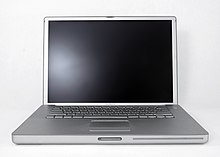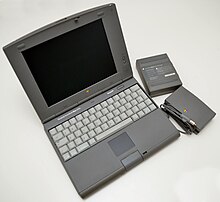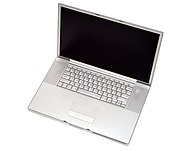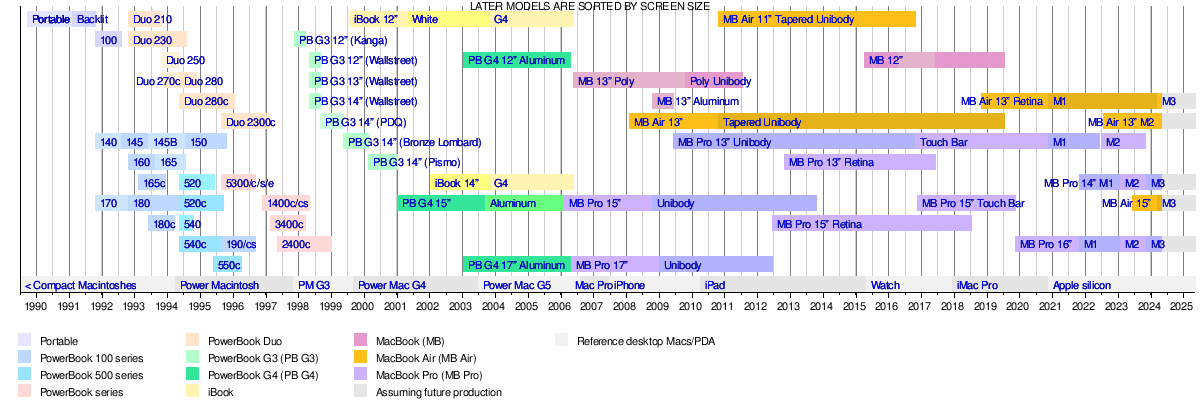
The Power Macintosh, later Power Mac, is a family of personal computers designed, manufactured, and sold by Apple Computer, Inc as the core of the Macintosh brand from March 1994 until August 2006.

iBook is a line of laptop computers designed, manufactured, and sold by Apple Computer from 1999 to 2006. The line targeted entry-level, consumer and education markets, with lower specifications and prices than the PowerBook, Apple's higher-end line of laptop computers. It was the first mass consumer product to offer Wi-Fi network connectivity, which was then branded by Apple as AirPort.

A laptop computer or notebook computer, also known as a laptop or notebook, is a small, portable personal computer (PC). Laptops typically have a clamshell form factor with a flat panel screen on the inside of the upper lid and an alphanumeric keyboard and pointing device on the inside of the lower lid, although 2-in-1 PCs with a detachable keyboard are often marketed as laptops or as having a "laptop mode". Most of the computer's internal hardware is fitted inside the lower lid enclosure under the keyboard, although many laptops have a built-in webcam at the top of the screen and some modern ones even feature a touch-screen display. In most cases, unlike tablet computers which run on mobile operating systems, laptops tend to run on desktop operating systems, which were originally developed for desktop computers.

The Power Macintosh G3 is a series of personal computers designed, manufactured, and sold by Apple Computer from November 1997 to August 1999. It represented Apple's first step towards eliminating redundancy and complexity in the product line by replacing eight Power Macintosh models with three: Desktop and Mini Tower models for professional and home use, and an all-in-one model for education. The introduction of the Desktop and Mini Tower models coincided with Apple starting to sell build-to-order Macs directly from its web site in an online store, which was unusual for the time as Dell was the only major computer manufacturer doing this. Apple's move to build-to-order sales of the Power Macintosh G3 also coincided with the acquisition of Power Computing Corporation, which had been providing telephone sales of Macintosh clones for more than two years.

SuperDrive is the product name for a floppy disk drive and later an optical disc drive made and marketed by Apple Inc. The name was initially used for what Apple called their high-density floppy disk drive, and later for the internal CD and DVD drive integrated with Apple computers. Though Apple no longer manufactures computers that feature built-in SuperDrives, the name is still used when referring to Apple's external CD and DVD drive accessory (pictured).

The PowerBook Duo is a line of subnotebooks manufactured and sold by Apple Computer from 1992 until 1997 as a more compact companion to the PowerBook line. Improving upon the PowerBook 100's portability, the Duo came in seven different models. They were the Duo 210, 230, 250, 270c, 280, 280c, and 2300c, with the 210 and 230 being the earliest, and the 2300c being the final incarnation before the entire line was dropped in early 1997.

The PowerBook G4 is a series of notebook computers manufactured, marketed, and sold by Apple Computer between 2001 and 2006 as part of its PowerBook line of notebooks. The PowerBook G4 runs on the RISC-based PowerPC G4 processor, designed by the AIM (Apple/IBM/Motorola) development alliance and initially produced by Motorola. It was built later by Freescale, after Motorola spun off its semiconductor business under that name in 2004. The PowerBook G4 has had two different designs: one with a titanium body with a translucent black keyboard and a 15-inch screen; and another in an aluminum body with an aluminum-colored keyboard, in 12-inch, 15-inch, and 17-inch sizes.

The PowerBook G3 is a series of laptop Macintosh personal computers designed, manufactured, and sold by Apple Computer from 1997 to 2001. It was the first laptop to use the PowerPC G3 (PPC740/750) series of microprocessors, and was marketed as the fastest laptop in the world for its entire production run. The PowerBook G3 was succeeded by the PowerBook G4.
Outbound Systems, Inc., was an American computer company based in Boulder, Colorado. Founded by Warren Conner in 1989, the company offered Macintosh clone computer systems in various portable form factors between 1989 and 1991. It left the Mac conversion business in 1992 to build Windows-based desktop computers before going bankrupt in 1993.

The PowerBook 500 series is a range of Apple Macintosh PowerBook portable computers first introduced by Apple Computer with the 540c model on May 16, 1994. It was the first to have stereo speakers, a trackpad, and Ethernet networking built-in.
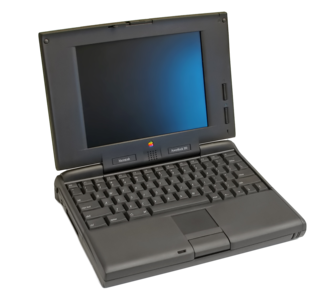
The PowerBook 190 and its companion PowerBook 190cs are laptop computers manufactured by Apple Computer as part of their PowerBook brand, introduced to the market in August 1995. The two models differ only in their screen: the 190 had a 9.5" greyscale display, while the 190cs featured a 10.4" color display. Apple's target sales audience for this model was the college student in need of a no-frills portable computer.

The PowerBook 3400c is a laptop computer in the PowerBook line manufactured by Apple Computer from February to November 1997. It was briefly the fastest laptop in the world. Using the PowerPC 603e processor running at speeds of up to 240 MHz, this PowerBook was the first to feature a PCI architecture, EDO memory, and a 64-bit wide, 40 MHz internal bus. It was also the first PowerBook to feature a PC card slot capable of being used as a zoomed video port. Like all Apple laptops since the PowerBook 500 series, it featured a built-in trackpad as the pointing device.
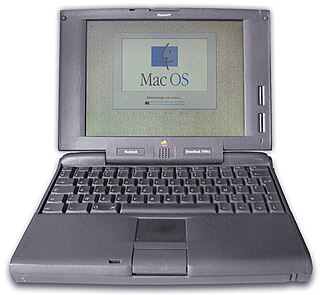
The PowerBook 5300 is the first generation of PowerBook laptops manufactured by Apple Computer to use the PowerPC processor. Released in August 1995, these PowerBooks were notable for being the first to feature hot-swappable expansion modules for a variety of different units such as Zip drives; PC Card slots as standard; and an infrared communication port. In common with most preceding Macintosh portables, SCSI, Serial, and ADB ports were included as standard. An internal expansion slot was also available for installing a variety of modules including Ethernet and video cards to drive a second monitor in mirroring or dual-screen modes.
The Macintosh LC 500 series is a series of personal computers that were a part of Apple Computer's Macintosh LC family of Macintosh computers, designed as a successor to the compact Macintosh family of computers for the mid-1990s mainstream education-market. The all-in-one desktop case is similar to the then recently introduced Macintosh Color Classic, but the LC 500 series is considerably larger and heavier due to its larger screen and a bulging midsection to house the larger electronics, including a 14" CRT display, CD-ROM drive, and stereo speakers.
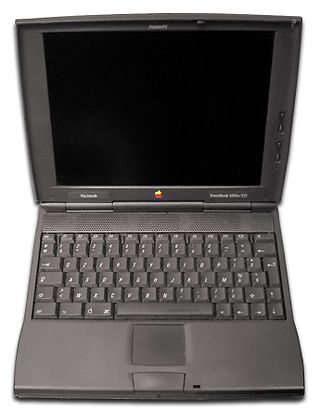
The PowerBook 1400 is a notebook computer that was designed and sold by Apple Computer, Inc. from 1996 to 1998 as part of their PowerBook series of Macintosh computers. Introduced in October 1996 at a starting price of $2,499, it was the first new PowerBook after the controversial PowerBook 5300. After the introduction of the more powerful PowerBook 3400c in February 1997, the 1400 took on the role of Apple's entry level notebook and remained there until its discontinuation in May 1998. Its successor, the PowerBook G3 Series, would ultimately go on to replace and consolidate not only the 1400, but the 2400c and 3400c as well.
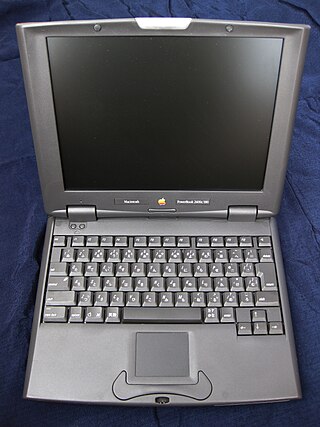
The PowerBook 2400c is a subnotebook in Apple Computer's PowerBook range of Macintosh computers, weighing 4.4 pounds (2.0 kg). Manufacturing was contracted to IBM Japan. In a return to the PowerBook 100 form factor, it was introduced in May 1997 as a late replacement for the PowerBook Duo 2300c, which had been the last of the subnotebook PowerBook Duo series. The 2400c was discontinued in March 1998, with no immediate replacement — the model that followed it was the much larger PowerBook G3 Series. However, in Japan a 2400c with a 240 MHz CPU was offered shortly after the original model's discontinuation, until the end of the year.
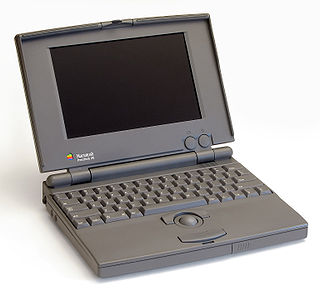
The PowerBook 100 is a notebook-sized laptop computer designed and manufactured by Sony for Apple Computer and introduced on October 21, 1991, at the COMDEX computer expo in Las Vegas, Nevada. Priced at US$2,500 with external floppy drive, the PowerBook 100 was the low-end model of the first three simultaneously released PowerBooks. Its CPU and overall speed closely resembled those of its predecessor, the Macintosh Portable. It had a Motorola 68000 processor at 16 MHz, 2-8 megabytes (MB) of RAM, a 9-inch (23 cm) monochrome backlit liquid-crystal display (LCD) with 640 × 400 pixel resolution, and the System 7.0.1 operating system. It did not have a built-in floppy disk drive and was noted for its unique compact design that placed a trackball pointing device in front of the keyboard for ease of use.

The PowerBook 100 series is a line of laptop PCs produced by Apple Computer.

The history of laptops describes the efforts, begun in the 1970s, to build small, portable Personal Computers that combine the components, inputs, outputs and capabilities of a Desktop Computer in a small chassis.

The IBM ThinkPad Power Series(800/820/821/822/823/850/851/860) is a laptop series from the ThinkPad line that was manufactured by IBM. It is based on the PowerPC architecture.
